The global aloe vera extract market size is calculated at USD 2.29 billion in 2024, grew to USD 2.51 billion in 2025 and is predicted to reach around USD 5.54 billion by 2034, expanding at a solid CAGR of 9.22% between 2024 and 2034. The Asia Pacific aloe vera extract market size accounted for USD 730 million in 2024 and is representing a notable CAGR of 9.40% during the forecast period.
The global aloe vera extract market size is accounted for USD 2.29 billion in 2024 and is projected to surpass around USD 5.54 billion by 2034, with a solid CAGR of 9.22% from 2024 to 2034. The demand for aloe vera extract is increasing rapidly. This is due to the growing awareness of the health benefits of aloe vera. In addition, the rising preference for natural and organic skincare products and aloe vera-based food and drinks boosts the market.
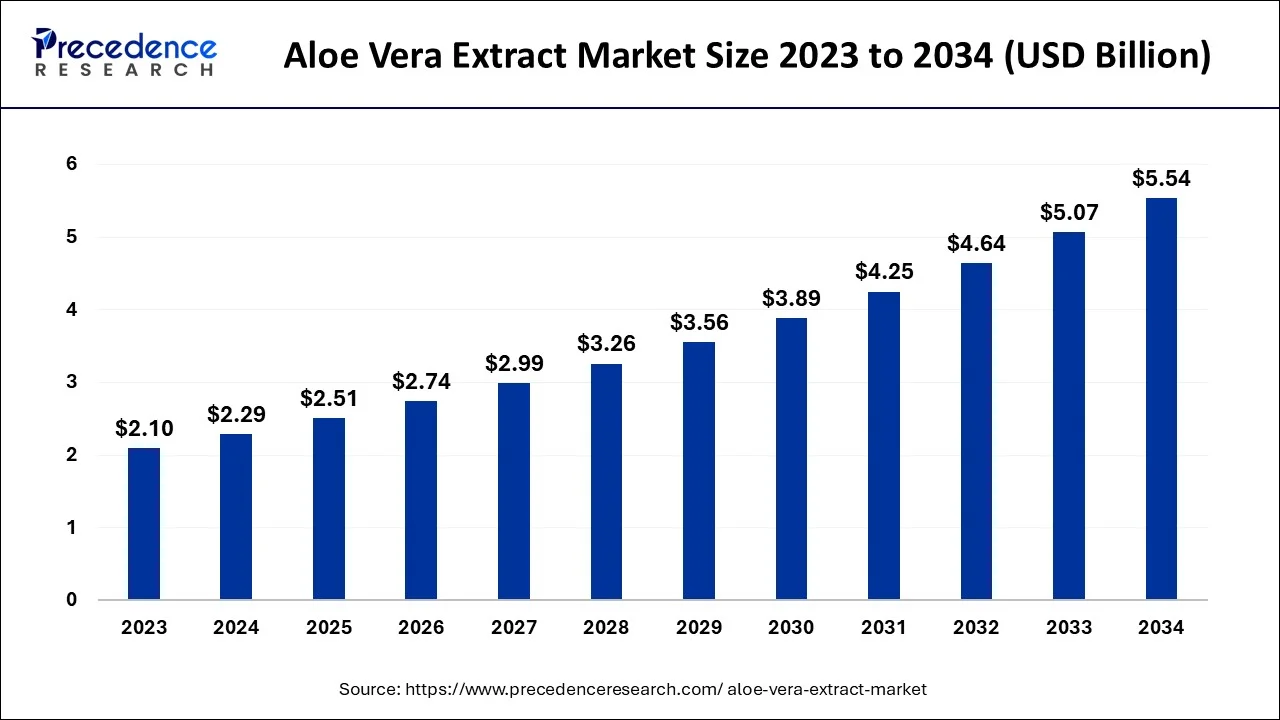
The U.S. aloe vera extract market size is evaluated at USD 550 million in 2024 and is projected to be worth around USD 1,360 million by 2034, growing at a CAGR of 9.52% from 2024 to 2034.
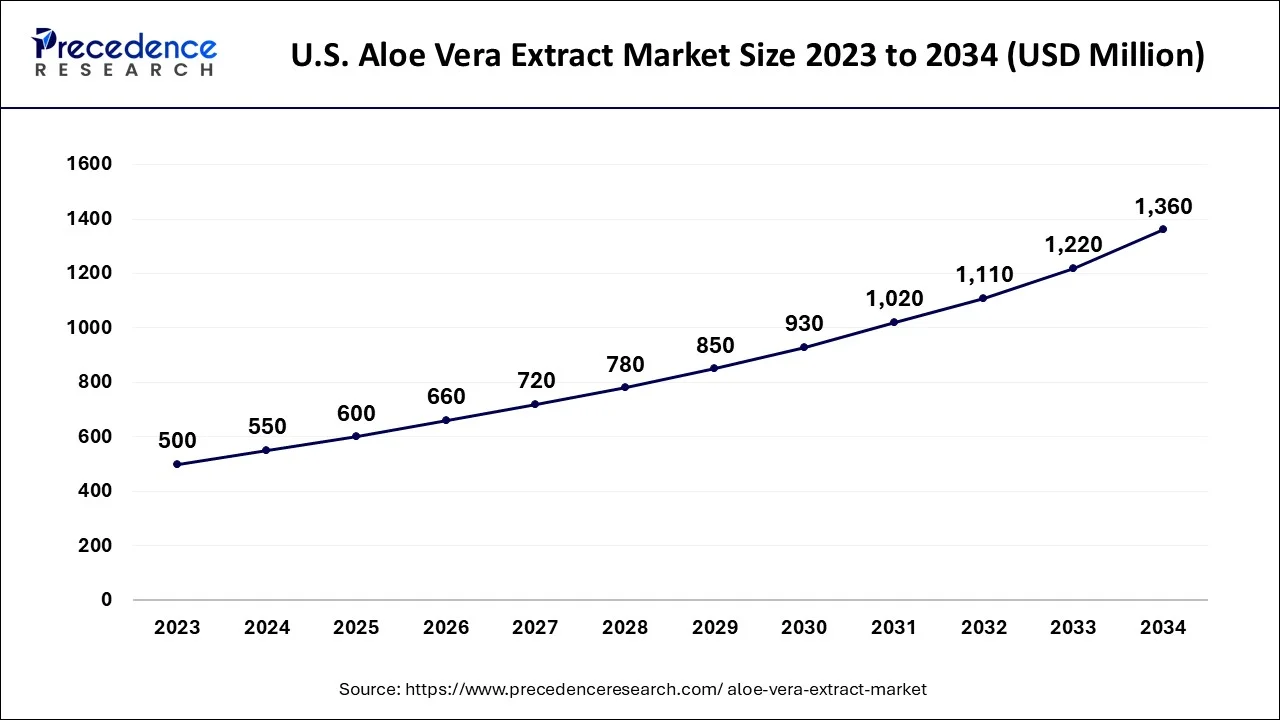
Asia Pacific held the largest share of the aloe vera extract market in 2023 and is observed to sustain the dominance throughout the forecast period due to the rising demand for Ayurvedic medicines. However, aloe vera has been used in Ayurveda in China and India for centuries. Moreover, the increasing demand for organic skincare products is likely to boost the market in the region. The growing middle-class population in countries like China and India is the key factor boosting the demand for skincare products in the region. In addition, the increasing focus on boosting the production of herbal cosmetics is projected to hold great market potential in the coming period.
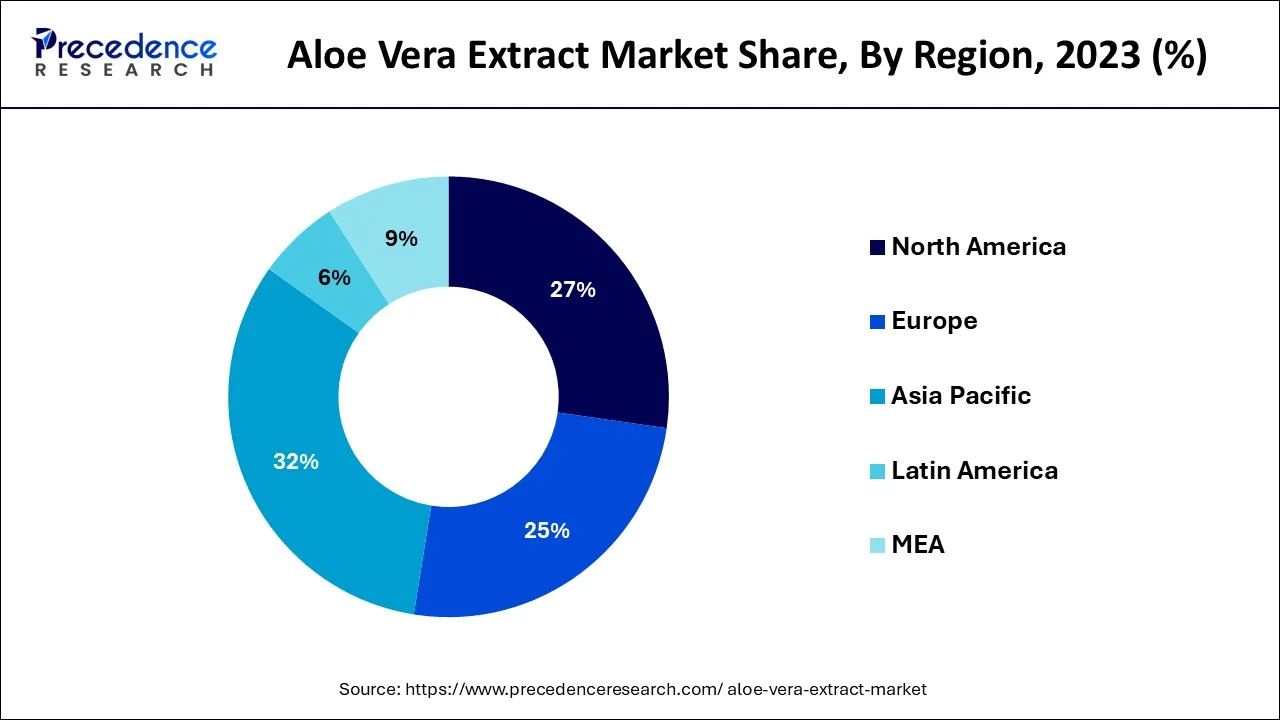
North America held a notable share of the aloe vera extract market in 2023. Continuous technological advancements have led to innovation in plant-based products in North America. The region has witnessed significant growth in the prevalence of diseases like cancer and liver ailments. However, the utilization of aloe vera extracts has increased in the region for the treatment of liver ailments due to their hydrating properties and richness in phytonutrients. Moreover, the heightened demand for dietary supplements to support immune and digestive systems further contributed to the regional market growth. The rising research and development activities to explore the efficacy of aloe vera extracts in treating various diseases bolstered the market in North America.
The awareness of health benefits associated with aloe vera extract has increased among people. Thus, the demand for products containing aloe vera extract is rising worldwide. Aloe vera extract is used in food & beverages, vitamins, and cosmetics. Due to the availability of anti-inflammatory agents in aloe vera, it is beneficial for acne reduction, facial spas, and various skin problems. The cosmetic industry uses aloe vera extract in facial creams and gels. Moreover, the pharmaceutical industry heavily uses aloe vera in various therapeutic approaches due to its medicinal properties, such as antioxidant, anti-inflammatory, and antimicrobial.
| Report Coverage | Details |
| Market Size by 2034 | USD 5.54 Billion |
| Market Size in 2024 | USD 2.29 Billion |
| Market Growth Rate from 2024 to 2034 | CAGR of 9.22% |
| Largest Market | Asia Pacific |
| Base Year | 2023 |
| Forecast Period | 2024 to 2034 |
| Segments Covered | Product, Application, Distribution Channel, and Regions |
| Regions Covered | North America, Europe, Asia-Pacific, Latin America and Middle East & Africa |
Increasing preference for natural and herbal remedies
With the growing preference for natural and herbal remedies, the usage of aloe vera extract is significantly rising in various industries. The utilization of aloe vera gels and leaf extracts has increased in the cosmetics industry. Their moisturizing and soothing properties make them suitable for use in skincare, personal hygiene, and hair care products. They have the ability to enhance the skin and hair texture.
Aloe vera gel also helps heal burns and wounds. Moreover, the pharmaceutical industry is drawing potential attention toward aloe vera extract because of its medical properties. Its regular consumption helps relieve gum inflammation, reduce constipation, and lower blood sugar levels. Ongoing research and developments in novel drug formulation significantly contribute to the global aloe vera extract market expansion.
Lack of protocols
The lack of protocols related to quality control during the manufacturing of aloe vera-based products can hamper the global market. The aloe vera extract composition varies based on the climatic conditions, plant variety, and plant age. The number and amount of active ingredients in a product depend on the processing method.
The manufacturing process of products containing aloe vera extracts encompasses crushing or grinding the aloe vera leaf, followed by filtration and stabilization processes to create juice. This method can result in a product that contains little or no active ingredients, and it is impossible to prevent contamination by leaf exudates. Moreover, the aloe vera extract market faces supply chain challenges, restraining market growth.
Increasing demand for dietary and organic drinks
The increasing use of aloe vera in food & beverages holds great market potential. Due to the increased focus on healthy eating, consumers are demanding dietary and organic drinks. Health-conscious consumers are attracted to aloe vera juice due to its perceived health benefits, like providing essential vitamins and minerals and aiding digestion. Moreover, the Food and Drug Administration (FDA) has already approved the use of aloe vera as a natural flavoring substance in food. Thus, various manufacturers are focusing on incorporating aloe vera extracts in beverages and dietary supplements to meet the overall growing demand.
The liquid segment dominated the aloe vera extract market with the largest share in 2023. Liquid aloe vera extract has multiple advantages for skin health, increasing its demand in the cosmetic and personal care industry. Liquid extract is cost-effective compared to gel and powders. It can easily be blended into beverages and cosmetic and pharmaceutical products. This convenience factor is the major contributor to segmental expansion.
The gel segment is expected to expand at the fastest rate in the coming years. This is mainly due to the increasing adoption of aloe vera gel in skincare and cosmetic products. Aloe vera gel is commonly used in skincare products due to its soothing, anti-aging, cleansing, and moisturizing properties. Moreover, its anti-inflammatory property helps in wound healing, as it increases the collagen content of the wound, thus increasing its usage in ointments.
The cosmetics segment led the aloe vera extract market in 2023. This is primarily due to the rising demand for herbal skincare products. Aloe vera is perceived as a natural moisturizer. It helps reduce pimples and acne and provides freshness to the skin. Aloe vera extracts are widely used in skincare products, such as moisturizers, face masks, lotions, anti-aging creams, sunscreens, and facial cleansers, due to their ability to hydrate the skin. The growing awareness about the drawbacks of synthetic ingredients in cosmetics is the key factor boosting the demand for herbal skincare products, significantly boosting the segment.
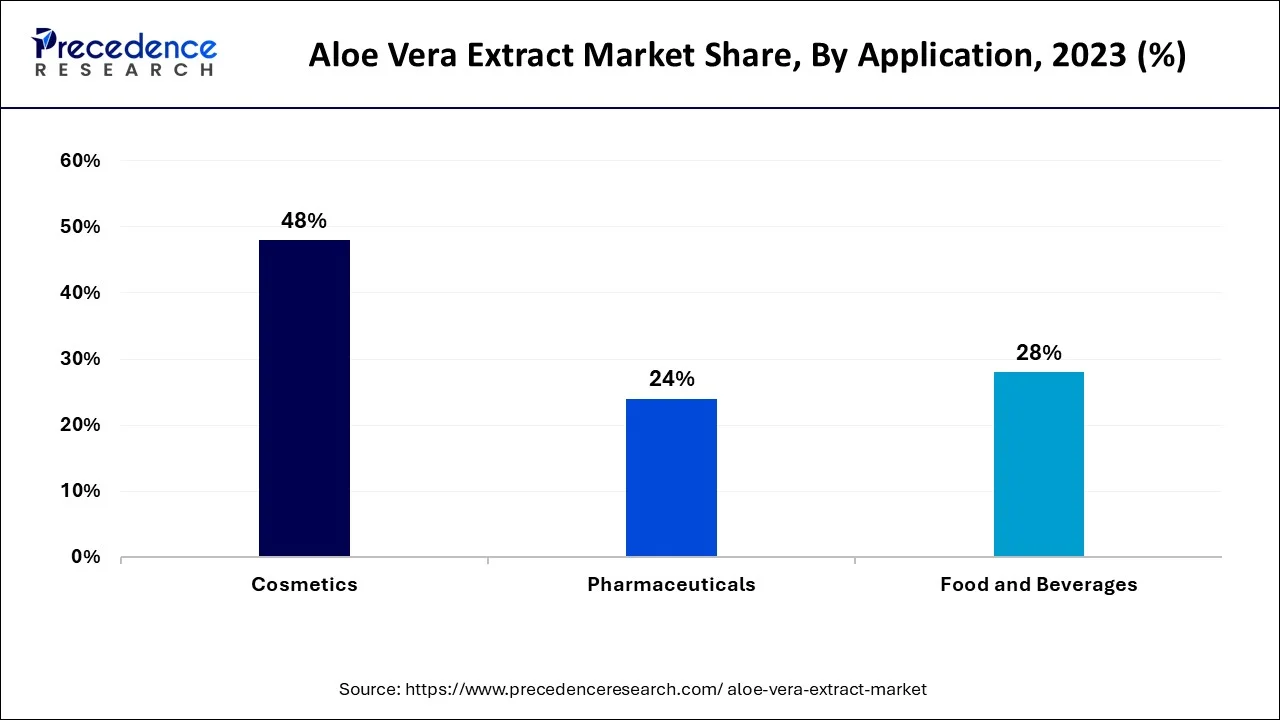
The pharmaceuticals segment is anticipated to expand at the highest CAGR during the forecast period. The pharmaceutical industry witnessed high demand for aloe vera-based products due to the growing prevalence of allergies and digestive disorders. Aloe vera extracts can help treat burns, skin irritations, wounds, and inflammations. In addition, with the growing health-conscious population, the demand for dietary supplements is increasing rapidly. However, aloe vera extract contains bioactive compounds, vitamins, and minerals that help in digestion and support the immune system.
The offline segment dominated the market in 2023. This is due to the availability of a wide range of options under a single roof. Easy purchases in retail stores, supermarkets, and convenience stores further contributed to segmental growth. Additionally, these stores allow customers to physically test the product before purchasing. This, in turn, enhances customer satisfaction and the buying experience.
The online segment is projected to grow at a significant pace over the studied period, owing to the rapid expansion of e-commerce businesses. Online stores allow consumers to purchase products from the comfort of their own homes. Moreover, these stores allow them to compare products with different brands and provide doorstep delivery. This convenience factor attracts more consumers, thus propelling the segment.
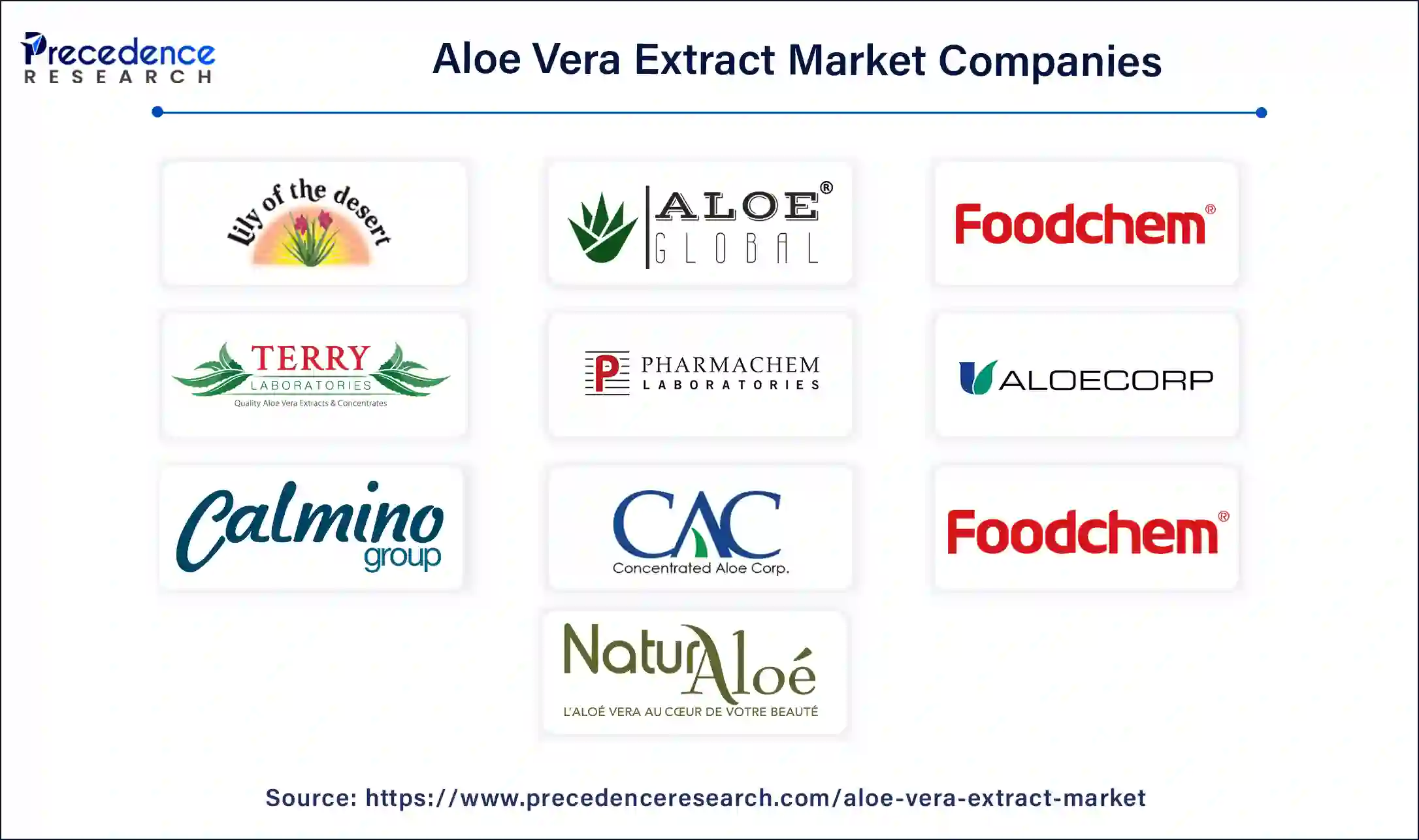
Segments Covered in the Report
By Product
By Application
By Distribution Channel
By Geography
For inquiries regarding discounts, bulk purchases, or customization requests, please contact us at sales@precedenceresearch.com
No cookie-cutter, only authentic analysis – take the 1st step to become a Precedence Research client